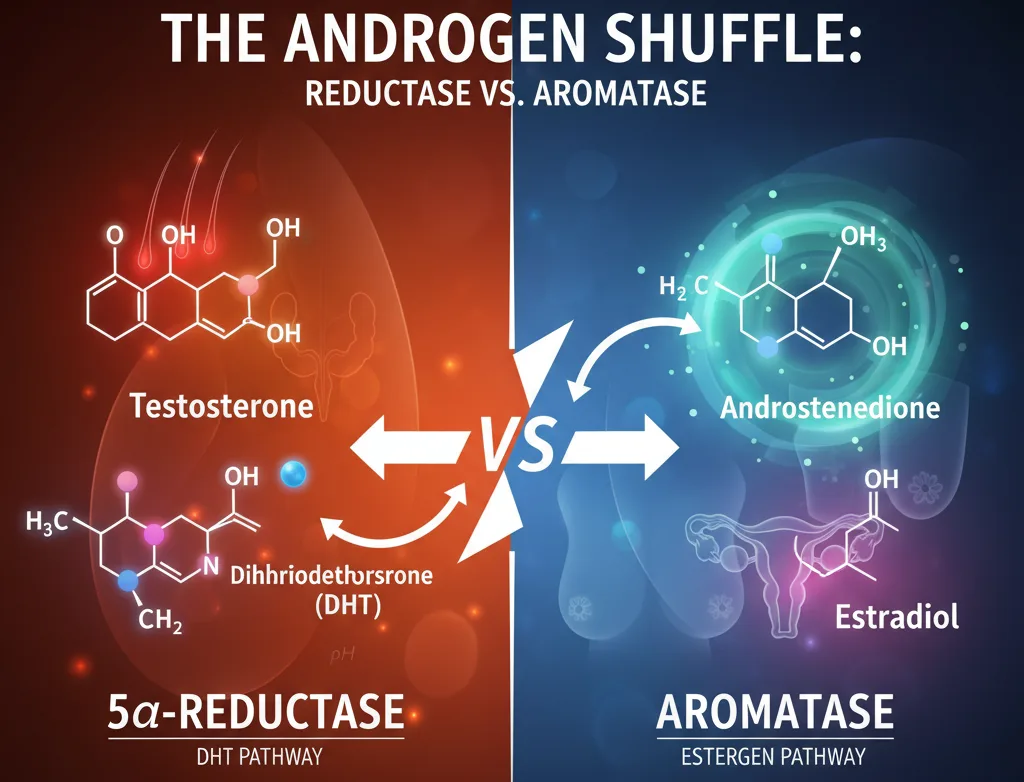In the intricate world of human hormones, two key enzymes manage the levels and effects of androgens (male sex hormones) and estrogens (female sex hormones): 5α-Reductase and Aromatase. While they both process steroid hormones, their actions, locations, and biological outcomes are fundamentally different, making them critical, yet distinct, therapeutic targets.
1. 5α-Reductase Type 2: The DHT Pathway
The primary role of the 5α-Reductase type 2 (5αR2) enzyme is to create a more potent form of the male hormone Testosterone (T).
The Conversion
5αR2 catalyzes a reduction reaction, converting Testosterone into Dihydrotestosterone (DHT). This reaction is crucial because DHT is a significantly more powerful androgen than T itself, often by a factor of two to three.
Biological Significance
5αR2 is vital for processes requiring strong androgen signaling, primarily in target tissues rather than throughout the systemic circulation:
-
Fetal Development: It is essential for the proper formation of the male external genitalia (penis, scrotum) during embryonic development.
-
Adulthood: It drives prostate growth, contributes to male-pattern baldness (androgenic alopecia), and stimulates the growth of facial and body hair.
Key Characteristics (5αR2)
-
Tissue Location: Highly expressed in the prostate, seminal vesicles, and genital skin.
-
Enzyme Kinetics: It exhibits a high affinity for its substrate T, reflected by a very low Michaelis constant (Km), typically in the range. This allows it to work efficiently even when T concentrations are low.
-
Optimal pH: This isoform is optimally active in an acidic environment ().
-
Clinical Target: Inhibitors of this enzyme (like Finasteride) are used to treat Benign Prostatic Hyperplasia (BPH) and androgenic alopecia (hair loss).
2. Aromatase: The Estrogen Pathway
Aromatase (also known as estrogen synthetase or CYP19A1) belongs to a completely different enzyme family (Cytochrome P450) and is responsible for producing the female sex hormones.
The Conversion
Aromatase catalyzes the final and rate-limiting step in estrogen synthesis: the aromatization of C19 androgens into C18 estrogens.
-
Androstenedione (an androgen) → Estrone (E1) (an estrogen)
-
Testosterone (an androgen) → Estradiol (E2) (an estrogen)
Biological Significance
Aromatase is the only enzyme capable of producing estrogen, making it essential for:
-
Female Development & Reproduction: Critical for the menstrual cycle, breast development, and maintaining bone health in both sexes.
-
Localized Production: It is the dominant source of estrogen in postmenopausal women and in tissues like fat and muscle.
Key Characteristics (Aromatase)
-
Tissue Location: Found in the ovaries, placenta, adipose (fat) tissue, brain, skin, and breast tissue.
-
Clinical Target: Aromatase Inhibitors (like Anastrozole or Letrozole) are a mainstay in the treatment of hormone-sensitive breast cancer because they block the production of estrogen that fuels tumor growth.
Summary of Distinction
Understanding the distinct roles of these two enzymes is key to appreciating the complex balance of steroids in the body and the pharmacological strategies used to manage hormone-related disorders.
